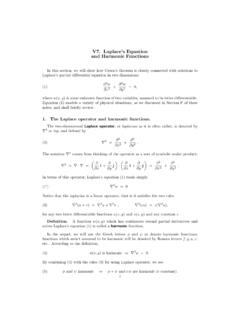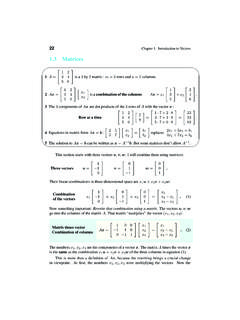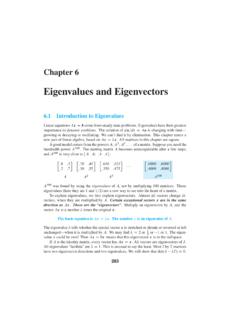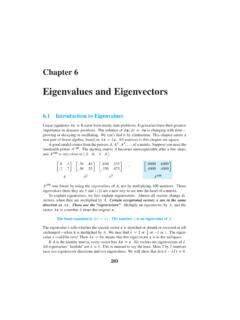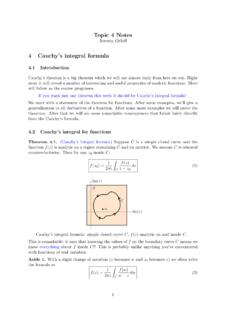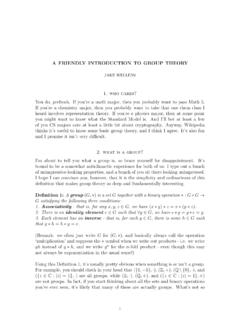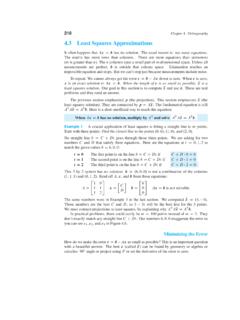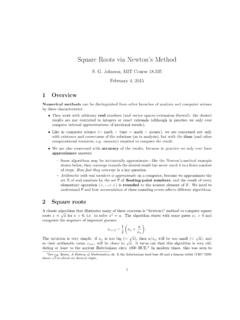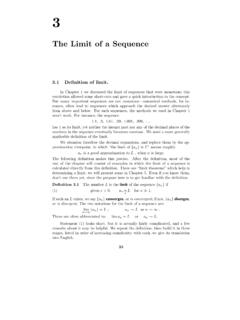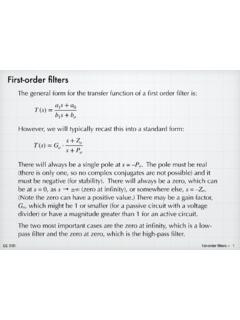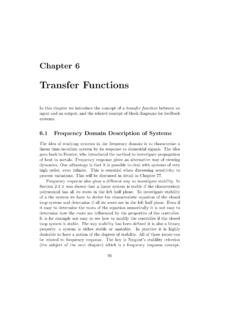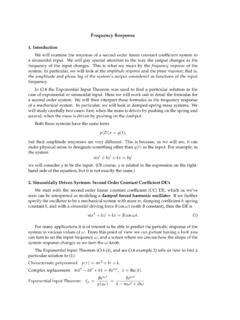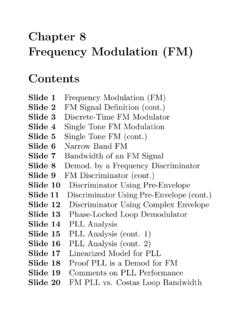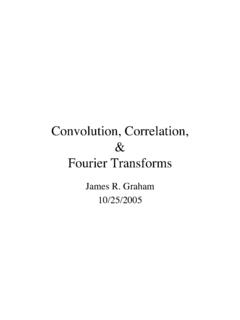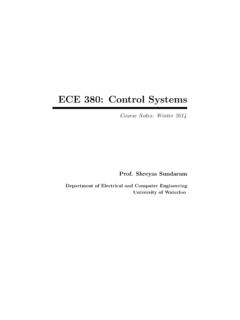Transcription of Step and Delta Functions Haynes Miller and Jeremy Orlo 1 ...
1 Step and Delta Miller and Jeremy Orloff1 The unit step DefinitionLet s start with the definition of the unit step function,u(t):u(t) ={0fort <01fort >0We do not defineu(t) att= 0. Rather, att= 0 we think of it as in transitionbetween 0 and is called the unit step function because it takes a unit step att= 0. It is sometimescalled the Heaviside function. The graph ofu(t) is (t)We will useu(t) as an idealized model of a natural system that goes from 0 to 1 veryquickly. In reality it will make a smooth transition, such as the (t) is an idealized version of this curveBut, if the transition happens on a time scale much smaller than the time scale ofthe phenomenon we care about then the functionu(t) is a good approximation. It isalso much easier to deal with of our main uses foru(t) will be as a switch. It is clear that multiplying afunctionf(t) byu(t) givesu(t)f(t) ={0fort <0f(t)fort > say the effect of multiplying byu(t) is that fort <0 the functionf(t) is switchedoff and fort >0 it is switched Step and Delta Integrals ofu (t)From calculus we know that u (t)dt=u(t) +cand bau (t)dt=u(b) u(a).}}
2 For example: 5 2u (t)dt=u(5) u( 2) = 1, 31u (t)dt=u(3) u(1) = 0, 3 5u (t)dt=u( 3) u( 5) = fact, the following rule for the integral ofu (t) over any interval is obvious bau (t) ={1if 0 is inside the interval (a,b)0if 0 is outside the interval [a,b].(1)Note:If one of the limits is 0 we throw up our hands and refuse to do the 0 be infinitesimally to the left of 0 and 0+infinitesimally to the right of 0. Thatis,0 <0<0+.For a function,f(0 ) is defined as the left hand limit at 0 or equivalently the limitfrom below at 0, provided this limit exists. Likewisef(0+) is the right hand limit orthe limit from (0 ) = limt 0f(t)f(0+) = limt 0f(t)Here are some examples of integrals ofu that involve 0 and 0+: 0+ u (t)dt= 1 (because <0<0+), 0 u (t)dt= 0 (because <0 <0), 0+0 u (t)dt= 1 (because 0 <0<0+). Step and Delta Preview of generalized Functions and derivativesOf courseu(t) is not a continuous function, so in the sense its derivative att= 0 does not exist.}
3 Nonetheless we saw that we could make sense of the integralsofu (t). So rather than throw it away we callu (t) the generalized derivative ofu(t).You can t do everything withu (t) you can do with an ordinary function, but it cango anywhere we have an input function in In the next section we will look inmore detail atu (t) and call it (t). For now we ll content ourselves with computingthe Laplace transform ofuandu . The Laplace transform ofu(t)andu (t)This is easy sinceu(t) is identical to the constant function 1 on the interval (0, ) ofthe Laplace transform. ThereforeL(u(t)) = 1/s.(We could also compute this directly from the definitionL(u) = 0 u(t)e stdt.)Foru , we use the formulaL(u ) =sL(u) u(0 ) and the fact thatu(0 ) = 0 to getL(u ) =s 1s= The unit step responseSuppose we have an LTI system with system functionH(s). The unit step responseof this system is defined as its response to inputu(t) with rest initial Laplace transform of the unit step response isH(s) is a triviality since in the frequency domain: output = transfer function the system x+ 2x=f(t), with inputfand responsex.
4 Findthe unit step :We havef(t) =u(t) and rest initial conditions. The system function is1/(s+ 2), so by the theorem, the unit step response written in terms of frequency isgiven byX(s) =1s(s+ 2)The partial fractions decomposition isX(s) =12(1s 1s+ 2),so in the time domainthe unit step response isx(t) =12 12e 2tfort >0.(Of coursex(t) = 0 fort <0.) Step and Delta Functions4 Example the previous example, find the long-term behavior of the unit stepresponse in two :Method 1: Compute the limit x(t) = limt 12 12e 2t= 2: Use the final value theorem. (If you haven t covered that in class just skipthis method or go back and read about the final value theorem in the reading onLaplace transform.) We havesX(s) = 1/(s+ 2). Since all its poles are negative, wecan apply the final value theorem:limt x(t) = lims 0sX(s) = see that both methods agree!2 The unit impulseIn this section we will learn about the unit impulse function (t). We will use it asinput to LTI systems.
5 At first the systems will be simple enough to find the post-initial conditions directly and use them to solve the equations for the response . Formore complicated systems we will use the Laplace transform to solve the equationwithout first determining the post-initial The mathematics of the Delta functionLet s delve a little deeper intou (t). It s clearu (t) = 0 ift6= 0. Att= 0 the curveis vertical so the slope is infinite, (0) = . (If you think ofu(t) as an idealizedversion of the curve in Figure 1, then we would say the derivative near 0 gets verylarge.) We define (t) =u (t)and call it the Delta function or the Dirac Delta function or the unit impulse have seen the following properties of (t).1. (t) ={0ift6= 0 ift= (t)dt=u(t)and (t)dt= on property 1, we graph (t) as an infinite spike at the origin. The integralsshow that the area under this graph equals 1 and it is all concentrated at the Step and Delta Functions5t0 (t)t0a (t a)We also show (t a) which is just (t) shifted to the The non-idealized Delta functionJust like the unit step function, the function is really an idealized view of reality, a Delta function is nearly a spike near 0 which goes up and down on a timeinterval much smaller than the scale we are working on.}
6 The integral, area underthe curve, is always 1. It s graph might actually look something liketFigure 2. Non-idealized Delta function; area under the graph = total amount input is still the integral (see Section below), or, in geometricterms, the area under the graph. For a unit impulse we assume the area is Delta Functions are your Integrals with (t)Recall how painful integration could be. In contrast, integrals with Delta functionsare always easy and involve no techniques of we scale (t): the integrals are just scaled. 5 53 (t)dt= 3, 3 53 (t)dt= 0, 0+0 3 (t)dt= 3, 0+3 (t)dt= integral baf(t) (t)dtis also easy. Iff(t) is continuous att= 0 then baf(t) (t)dt={f(0)if (a,b) contains 00if [a,b] does not contain is, integrating against (t) just amounts to evaluatingf(t) att= Step and Delta Functions6 Note one of the endpointsaorbis 0, the integral cannot be evaluated, so wejust throw up our hands and refuse to do : We must havef(t) continuous att= Justification of the formula for f(t) (t)dtWe should start by admitting that in formal mathematics this is simply given asthe definition of (t), so our arguments will just go to show that it is a reasonabledefinition.}
7 We ll do this in three reason: (t) is 0 everywhere exceptt= 0, Sof(t) (t) is 0 for allt6= 0 andatt= 0 it just scales the Delta function byf(0). That is,f(t) (t) =f(0) (t).Reason we can interpret the integral as area, we need to show that the area underf(t) (t) isf(0). Figure 2 (above) shows a tall, thin curve neart= 0which approximates (t). Sincef(t) is continuous we know thatf(t) f(0) neart= 0. Thus,f(t) (t) is approximated by the graph in the figure scaled byf(0).Finally, since the area under the curve in Figure 2 is one, if we scale it byf(0) it willhave area equal tof(0). As the graph in Figure 2 gets narrower and taller it goes tothat of (t). As this happens, the approximation we just made will become exact, we wanted to show, the area under thef(t) (t) =f(0).Reason is a direct argument using integration by parts. First, since (t) = 0fort6= 0 the integral baf(t) (t)dtmust be zero for any interval [a,b] not containing0.
8 Next, supposea <0< b, then we get baf(t) (t)dt= baf(t)u (t)dt(since =u )=f(t)u(t)|ba baf (t)u(t)dt(integration by parts)Now, sinceu(b) = 1,u(a) = 0 andu(t) = 0 fort <0 this becomes=f(b) b0f (t)dt=f(b) f(t)|b0=f(b) f(b) +f(0)=f(0)Comparing the first and last expressions in this long sequence of steps, we ve shownthe Step and Delta Shifting by aIf we shift byawe have, f(t) (t a) =f(a). More generally: dcf(t) (t a)dt={f(a)if (c,d) contains a0if [c,d] does not contain 3.(Practice with .) Quickly cover up the answers on the left and try toevaluate each of the integrals on the right. 3 1 (t)2e4t2dt= 2,(evaluate 2e4t2att= 0) 31 (t)2e4t2dt= 0,(0 is not in [1,3]) 30 (t)2e4t2dt= 2,(evaluate 2e4t2att= 0) 0 (t)2e tan2(t3)dt= 2,(evaluate 2e tan2(t3)att= 0) 3 1 (t 2)2e4t2dt= 2e16,(evaluate 2e2e4t2att= 2) 53 (t 2)2e4t2dt= 0,(2 is not in [3,5]) 30 (t 2)2e4t2dt= 2e16(evaluate 2e2e4t2att= 2), 0 (t 2)2e tan2(t3)dt= 2e tan2(8)(evaluate 2e tan2(t3)att= 2). The physical interpretation of Delta Functions as a unitimpulseIn general, we will be using Functions as the input to LTI systems.}
9 So, in thissubsection we want to explore what this means. Our goal is to understand what ismeant by an impulse and to see that (t) can be thought of as an (idealized) the rate equation x+kx=f(t). To be specific, assumexisin units of kilograms andtis in minutes. This is a rate equation and the derivative xand the inputf(t) are rates, in units of kg/min. We then have that the total amountof kg input from time 0 to timetis t0 f( )d .Consider the following possible inputsf(t), shown graphically as box Step and Delta Functions8tf1(t) kg/min21/2tf2(t) kg/min41/4tf3(t) kg/min61/6 Look at the input functionf1(t) in the leftmost figure. It is only nonzero in theinterval [0,1/2] during which time it inputs at a constant rate of 2 kg/min. The totalamount input over that time is 1/20f1(t)dt= functionf2has a higher rate, but acts for a shorter time. The total amount itinputs over time is also 1 kg. The functionf3is similar: it acts for even a shortertime, but inputs a total of 1 (0) =x0kg, then over the interval [0,1/2] some of what is added byf1(t) willdecay away and we ll end with something less thanx0+ 1 kg.
10 But, the shorter theinterval the less time there is to decay and the amount at the end will be closer tox0+ 1. If we continue to shorten the time interval in which we input a total of 1 kgthen in the limiting case we will dump 1 kg in all at once. In this case there willbe no time for decay and the amount will jump instantaneously fromx0tox0+ 1,after which it will start decaying. This instantaneous input is called an impulse; aninstantaneous input of one unit is called a unit impulse. In a first order system animpulse results in an instantaneous jump in the amount that as the length of the time interval goes to 0, the ratef(t) must go to all along the total kg input remains constant. That is the integral f(t)dt= (t) be the box function of widthhand height 1/h. Then the integral uh(t)dt= 1 andlimh 0uh(t) = (t).That is, as the boxes get narrower and taller they become the saw above that (t) was described by two properties1. (t) ={0ift6= 0 ift= (t)dt=u(t), (t)dt= picture below illustrates that limh 0uh(t) satisfies property 1.}
